Abstract
The present study investigates the occurrence and experience of sexual betrayal in adolescents and young adults from the perspectives of both the perpetrator and the aggrieved. Subjects (N = 216) who had been in monogamous relationships were asked whether they had ever cheated on their partner (by petting or having sexual relations with another) and whether their partner had ever cheated on them. Subjects also reported their motives and reactions and the consequences associated with these betrayals. Approximately two-thirds of the sample had experienced betrayal, as the perpetrator, the aggrieved, or both. Perpetrators typically know their betrayal partners and are motivated by sexual attraction, the regular partner's absence, and the influence of drugs or alcohol. Although 42% of betrayals are not discovered by the aggrieved, the majority of those that are discovered result from confessions by the perpetrator. As expected, those who are betrayed generally react with anger or sadness. Perpetrators often feel guilty, but also report a number of positive emotions, suggesting that betrayal may play an important role as adolescents struggle to establish their identities. Gender differences were absent in the incidence, motives, and experience of sexual betrayal. Results are interpreted in terms of competing demands of intimacy and identity formation.
Similar content being viewed by others
REFERENCES
Berndt, T., and Perry, T. (1990). Distinctive features and effects of early adolescent friendships. In Montemayor, R., Adams, G., and Gullota, T. (eds.), Advances in Adolescence Research (Vol. 2). Sage, Beverly Hills, CA, pp. 269–287.
Blumstein, P., and Schwartz, P. (1983). American Couples. Morrow, New York.
Buss, D. (1995). Psychological sex differences: Origins through sexual selection. Am. Psychol. 50: 164–168.
Buunk, B. (1980). Extramarital sex in the Netherlands: Motivation in social and marital context. Altern. Lifestyles 3: 11–39.
Buunk, B. (1987). Conditions that promote breakups as a consequence of extra dyadic involvements. J. Soc. Clin. Psychol. 5: 271–285.
Buunk, B. (1995). Sex, self-esteem, dependency, and extradyadic sexual experience as related to jealousy response. J. Soc. Pers. Relat. 12: 147–153.
DeBurgher, J. E. (1972). Sex in troubled marriages. Sex. Behav. 2: 23–62.
Dyk, P., and Adams, G. (1987). The association between identity development and intimacy during adolescence: A theoretical treatise. J. Adolesc. Res. 2: 223–235.
Erikson, E. (1968). Childhood and Society (2nd Ed.). Norton, New York.
Erlbaum, P. L. (1982). The dynamics, implications, and treatment of extramarital sexual relationships for the family therapist. J. Marit. Fam. Therapy 7: 489–495.
Feldman, S. S., and Cauffman, E. (1999, in press). Your cheatin' heart: Sexual betrayal attitudes and behaviors and their correlates. J. Res. Adolesc. 9.
Glass, S. P., and Wright, T. L. (1992). Justifications for extramarital relationships: The association between attitudes, behaviors, and gender. J. Sex Res. 29: 361–387.
Greely, A. M. (1991). Faithful Attraction: Discovering Intimacy, Love and Fidelity in American Marriage. Doherty, New York.
Hansen, G. L. (1987). Extra dyadic reactions during courtship. J. Sex Res. 23: 382–390.
Johnston, L. D., O'Malley, P. M., and Bachman, J. G. (1993). National Survey Results on Drug Use from Monitoring the Future Study, 1975–1992. Volume 1. Secondary School Students. U.S. Department of Health and Human Services (National Institute on Drug Abuse Publ. No. 93–3597). U.S. Government Printing Office, Washington, DC.
Katchadourian, H. (1990). Sexuality. In Feldman, S. S., and G. R. (eds.), At the Threshold: The Developing Adolescent. Harvard University Press, Cambridge, MA, pp. 330–351.
Kitzinger, C., and Powell, D. (1995). Engendering infidelity: Existentialist and social constructionist readings of a story completion task. Fem. Psychol. 5: 345–372.
Lawson, A. and Samson, C. (1988). Age, gender and adultery. Br. J. Sociol. 39: 409–440.
Lieberman, B. (1988). Extrapremarital intercourse: Attitudes toward neglected sexual behavior. J. Sex Res. 24: 296–298.
Mongeau, P., Hale, J., and Alles, M. (1994). An experimental investigation of accounts and attributions following sexual infidelity. Commun. Monogr. 61: 326–344.
Moore, S., and Rosenthal, D. A. (1993). Sexuality in Adolescence. Routledge, New York.
Roscoe, B., Cavanaugh, L., and Kennedy, D. (1988). Dating infidelity: Behaviors, reasons, and consequences. Adolescence 23: 35–43.
Seal, D. W., Agostinelli, G., and Hannett, C. (1994). Extradyadic romantic involvement: Moderating of sociosexuality and gender. Sex Roles. 31: 1–22.
Sheppard, V., Nelson, E., and Andreoli-Mathie, V. (1995). Dating relationships and infidelity: Attitudes and behavior. J. Sex Marit. Therapy 21: 202–212.
Sponaugle, G. C. (1989). Attitudes towards extramarital relations. In McKenney, K., and Sprecher, S. (eds.), Human Sexuality: The Societal and Interpersonal Context. Ablex, Norwood, NJ, pp. 187–209.
Sprecher, S., and McKinney, K. (1993). Sexuality. Sage, Newbury Park, CA.
Sullivan, H. S. (1953). Conceptions of Modern Psychiatry. Norton, New York.
Thompson, A. P. (1983). Extramarital sex: A review of research literature. J. Sex Res. 19: 1–22.
Thompson, A. P. (1984). Emotional and sexual components of extramarital relations. J. Marr. Fam. 46: 35–42.
Townsend, J. M., and Levy, G. D. (1990). Effect of potential partner's costume and physical attractiveness on sexuality and partner selection. J. Psychol. 127: 371–389.
Weis, D. L. and Slosnerick, M. (1981). Attitudes toward sexual and nonsexual extramarital involvement among a sample of college students. J. Marri. Fam. 43: 349–358.
Wiederman, M. W., and Allgeier, E. R. (1993). Gender differences in sexual jealousy: Adaptionist as social learning explanation. Ethnol. Sociobiol. 14: 115–140.
Wiggins, J. D., and Lederer, D. A. (1984). Differential antecedents of infidelity in marriage. Am. Ment. Health Couns. Assoc. J. 6: 152–161.
Author information
Authors and Affiliations
Rights and permissions
About this article
Cite this article
Feldman, S.S., Cauffman, E. Sexual Betrayal Among Late Adolescents: Perspectives of the Perpetrator and the Aggrieved. Journal of Youth and Adolescence 28, 235–258 (1999). https://doi.org/10.1023/A:1021605532205
Issue Date:
DOI: https://doi.org/10.1023/A:1021605532205




